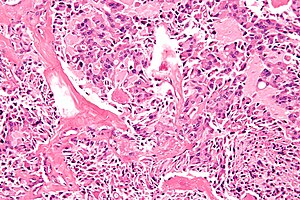Difference between revisions of "Medullary thyroid carcinoma"
Jump to navigation
Jump to search
| Line 22: | Line 22: | ||
| Symptoms = | | Symptoms = | ||
| Prevalence = uncommon | | Prevalence = uncommon | ||
| Bloodwork = serum calcitonin elevated | | Bloodwork = +/-serum calcitonin elevated | ||
| Rads = | | Rads = | ||
| Endoscopy = | | Endoscopy = | ||
Revision as of 05:35, 16 February 2014
| Medullary thyroid carcinoma | |
|---|---|
| Diagnosis in short | |
 Medullary thyroid carcinoma. H&E stain. | |
|
| |
| LM | nuclei with neuroendocrine features (round nuclei with salt-and-pepper chromatin), +/-amyloid deposits (fluffy appearing acellular eosinophilic material), +/-C-cell hyperplasia |
| Stains | congo red +ve (amyloid deposits) |
| IHC | calcitonin +ve, CEA +ve, chromogranin A +ve, synaptophysin +ve, thyroglobulin -ve (usually) |
| Gross | usu. well-circumscribed, white, gray or yellow, gritty, firm |
| Site | thyroid gland |
|
| |
| Associated Dx | C-cell hyperplasia |
| Syndromes | multiple endocrine neoplasia IIa, multiple endocrine neoplasia IIb |
|
| |
| Prevalence | uncommon |
| Blood work | +/-serum calcitonin elevated |
| Prognosis | poor |
Medullary thyroid carcinoma, abbreviated MTC, is an uncommon epithelial malignancy of the thyroid gland that may be syndromic.
General
Medical school memory device - 3 M's:
- aMyloid.
- Median node dissection done.
- MEN IIa syndrome/MEN IIb syndrome.
- Medullary thyroid carcinoma.
- Pheochromocytoma.
- Parathyroid adenoma.
Epidemiology:
- Very rare.
- Poor prognosis.
- May be genetic (MEN IIa/b syndrome).
- Arises from C cells (which produce calcitonin).
Syndromic tumours - typically:[1]
- Present in 30s or 40s.
- +/-Multifocal.
- +/-Bilateral.
- C-cell hyperplasia.
Serology:
- Serum calcitonin classically elevated.[2]
Gross
Features:[1]
- Usu. well-circumscribed.
- White, gray or yellow.
- Gritty.
- Firm.
Image:
Microscopic
Features:
- Nuclei with "neuroendocrine features".
- Small, round nuclei.
- Coarse chromatin (salt and pepper nuclei).
- +/-Amyloid deposits - fluffy appearing acellular eosinophilic material in the cytoplasm.
- +/-C-cell hyperplasia - seen with familial forms of MTC.
- C cells (AKA parafollicular cell): abundant cytoplasm - clear/pale.
Note:
- The amyloid is formed from calcitonin.[3]
DDx:
Images
www:
- Medullary thyroid carcinoma (bmj.com).
- C cell hyperplasia (nature.com).
- C cell (rutgers.edu).
- Parafollicular cells (anatomyatlases.org).
Stains
- Congo-red +ve (amyloid present) - mnemonic: CRAP -- congo red amyloid protein.
IHC
Features:[4]
- Calcitonin +ve - it arises from C cells (which produce calcitonin).
- Neuroendocrine markers.
- CEA +ve (often better staining than calcitonin).[5]
- Thyroglobulin usu. -ve.[6]
EM
- Neurosecretory granules.
- Feature seen in neuroendocrine tumours.
Images: Neurosecretory granules (ucsf.edu).
See also
References
- ↑ 1.0 1.1 Nosé, V. (Apr 2011). "Familial thyroid cancer: a review.". Mod Pathol 24 Suppl 2: S19-33. doi:10.1038/modpathol.2010.147. PMID 21455198.
- ↑ Vainas, I.; Marthopoulos, A.; Chrisoulidou, A.; Raptou, K.; Tziomalos, K.; Pazaitou-Panayiotou, K. (Jul 2013). "Calcitonin stimulation tests for the early diagnosis and follow-up of patients with C cell disease: a descriptive analysis.". Hippokratia 17 (3): 246-51. PMID 24470736.
- ↑ Khurana, R.; Agarwal, A.; Bajpai, VK.; Verma, N.; Sharma, AK.; Gupta, RP.; Madhusudan, KP. (Dec 2004). "Unraveling the amyloid associated with human medullary thyroid carcinoma.". Endocrinology 145 (12): 5465-70. doi:10.1210/en.2004-0780. PMID 15459123.
- ↑ URL: http://pathologyoutlines.com/thyroid.html#medullary. Accessed on: 17 January 2011.
- ↑ SB. 7 January 2010.
- ↑ de Micco, C.; Chapel, F.; Dor, AM.; Garcia, S.; Ruf, J.; Carayon, P.; Henry, JF.; Lebreuil, G. (Mar 1993). "Thyroglobulin in medullary thyroid carcinoma: immunohistochemical study with polyclonal and monoclonal antibodies.". Hum Pathol 24 (3): 256-62. PMID 8454270.


